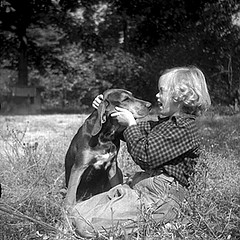Dog Breeds
Several types of dogs are believed to have originated in North Carolina and S outh Carolina and have been bred in these states for decades or even centuries, although they have generally gone unrecognized by official dog registries. Most of these breeds were developed during the colonial period to perform very special and necessary functions, such as driving flocks of turkeys to market or livestock to pasture. Like certain tools and weapons, dogs were developed to meet specialized needs in different locales or times.
outh Carolina and have been bred in these states for decades or even centuries, although they have generally gone unrecognized by official dog registries. Most of these breeds were developed during the colonial period to perform very special and necessary functions, such as driving flocks of turkeys to market or livestock to pasture. Like certain tools and weapons, dogs were developed to meet specialized needs in different locales or times.
The Plott hound, the state dog of North Carolina, is probably the best known of these "hidden" dog breeds. It was recognized in western North Carolina in the 1750s and reportedly named for Johannes Plott, who developed it as a hunting dog. The Carolina dog, on the other hand, is classified by experts as being of the ancient pariah type, descended from the original Native American canine breeds. It can still be found in the wild in South Carolina and along the Yadkin River near Salisbury,  N.C. Carolina dogs are good hunters and, if properly socialized, can become wonderful companions.
N.C. Carolina dogs are good hunters and, if properly socialized, can become wonderful companions.
The Boykin spaniel is another example of a dog breed unique to the Carolinas. It was developed in South Carolina for the challenges of turkey hunting, to fit into very small watercraft when the hunters were after waterbirds, or for other specific needs. The black mouth cur, also known as the southern cur or the yellow black mouth cur, is bred to hunt boar, raccoon, bear, and deer. It is a powerful dog with a deep bay and is excellent in treeing its quarry. The black mouth cur is also protective of children, and the males prefer women to men as companions. The leopard cur also has North Carolina roots. A big hound, it weighs from 45 to 77 pounds and has been used as a watchdog and for hunting game. It is usually a leopard-spotted merle color, although it can also be black and tan, dark brindled, or yellow. The leopard cur is a very hard worker and tends to be one-person dog.
Another "hidden" dog, recognized as the "dog of the Hunt Club of Pender County," was developed by the foxhunters of the Cape Fear region of eastern North Carolina to meet the challenges of the sport there. It is an excellent dog, and its antecedents go back to the late nineteenth or early twentieth centuries. Mention has been found of "scratch hall dogs" from the Dismal Swamp area of North Carolina, but very little can presently be verified concerning their heritage.
Image Credit:
One of the Plott's Plott Hounds, 1952, with a Plott little girl. From Conservation and Development Department, Travel and Tourism Division Photo Files, North Carolina State Archives, call #: C&D 8623-E. Available from https://www.flickr.com/photos/north-carolina-state-archives/2345301681/ (accessed September 11, 2012).
One of the Plott's Plott Hounds, 1952. From Conservation and Development Department, Travel and Tourism Division Photo Files, North Carolina State Archives, call #: C&D 8623-C. Available from https://www.flickr.com/photos/north-carolina-state-archives/2346129474/ (accessed September 11, 2012).
1 January 2006 | Porter, Joseph C.